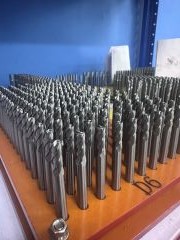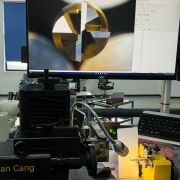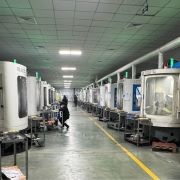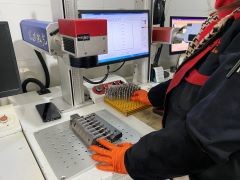1. WHAT IS THE CARBIDE BURR?
Carbide burr, also known as burr bit, burr cutter, carbide burr bit, carbide die grinder bit etc. Strictly speaking, the carbide burr is a kind of rotary cutting tool which is clamped on pneumatic tools or power tools and specially used to remove metal burr, welding scar, weld cleaning. It is mainly used in the rough machining process of the workpiece with high efficiency.
2. THE COMPONENT OF CARBIDE BURR?
Carbide burr can be divided into brazed type and solid type. The brazed type is made of carbide head part and steel shank part brazed together, when the diameter of burr head and shank are not same, the brazed type is used. The solid type is made of solid carbide when the diameter of burr head and shank are same.
3. WHAT IS CARBIDE BURR USED FOR?
Carbide burr have been widely used, it is an important way to improve production efficiency and achieve the mechanization of fitter. In recent years, with the increasing number of users, it has become a necessary tool for fitter and repairman.The main uses:♦ chip removing.♦ shape modification.♦ edge and chamfer finish.♦ perform preparatory milling for build up welding.♦ weld cleaning.♦ clean casting materials.♦ improve the geometry of the workpiece.
The main industries:♦ Mold industry. For finishing all kinds of metal mold cavity, such as shoe mold and so on.♦ Engraving industry. For engraving all kinds of metal and non-metal, such as craft gift.♦ Equipment manufacturing industry. For cleaning the fin, burr, welding-seam of casting, forge piece and weldment, such as casting machine factory, shipyard, wheel hub polishing in automotive factory, etc.♦ Machinery industry. For processing the chamfer, round, groove and keyway of all kinds of mechanical parts, cleaning pipes, finishing the surface of the inner hole of the machine parts, such as machinery factory, repair shop and so on.♦ Engine industry. For sleeking the flow pass of impeller, such as car engine factory.♦ Welding industry. For sleeking the welding surface, such as riveting welding.
4. THE ADVANTAGES OF CARBIDE BURR.♦ All kinds of metals (including hquenched steel) and non-metallic materials (such as marble, jade, bone, plastic) with hardness below HRC70 can be cut arbitrarily by carbide burr.♦ It can replace small grinding wheel with shank in most work, and no dust pollution.♦ High production efficiency, tens of times higher than the processing efficiency of manual file, and more than ten times higher than the processing efficiency of small grinding wheel with shank.♦ With good processing quality, high surface finish, carbide burr can process various shapes of mold cavity with high precision.♦ Carbide burr there is a long service life, 10 times more durable than high speed steel cutter, and 200 times durable more than aluminum oxide grinding wheel.♦ Carbide burr is easy to use, safe and reliable, it can reduce labor intensity and improve the working environment.♦ The economic benefit after use carbide burr is greatly improved, and the comprehensive processing cost can be reduced tens of times by use carbide burr.
5. THE RANGE OF MACHINED MATERIALS OF CARBIDE BURR.
Application
Materials
Used for deburring, milling of preparation process, surfacing welding, welding spot machining, forming machining, casting chamfering, sinking machining, cleaning.
Steel, Cast Steel
Not hard steel, not heat treated steel, strength not exceeding 1.200N/mm²(38HRC)
tool steel, tempered steel, alloy steel, cast steel
Stainless Steel
Rust proof and acid proof steel
austenitic and ferritic stainless steels
Nonferrous Metals
soft nonferrous metals
aluminum
brass, red copper, zinc
hard nonferrous metal
aluminum alloy, brass, copper, zinc
brass, titanium/titanium alloy, duralumin alloy (high silicon content)
heat-resisting material
Nickel base and cobalt base alloys (engine and turbine manufacturing)
Cast Iiron
grey cast iron, white cast iron
nodular graphite / ductile iron EN-GJS(GGG)
white annealed cast iron EN-GJMW(GTW),
black iron EN-GJMB(GTS)
Used for milling, forming processing
Plastic, Other Materials
fiber reinforced plastics (GRP/CRP), fiber content ≤40%
fiber reinforced plastics (GRP/CRP), fiber content >40%
Used for trimming,form milling of cutting hole
thermoplastic
6. THE MATCHING TOOLS OF CARBIDE BURR.
Carbide burr are usually used with high speed electric grinder or pneumatic tools, it also can be used by mounted on machine tools. Because of pneumatic tools are commonly used in industry, so the use of carbide burr in industry is generally driven by pneumatic tools. For personal use, electric grinder is more convenient, it works after you plug it in, without air compressor. All you need to do is choose a electric grinder with high speed. The recommended speed is generally 6000-40000 RPM, and a more detailed description of the recommended speed is given following.
7. THE RECOMMENDED SPEED OF CARBIDE BURR.Carbide burr should be operated at a reasonable speed of 1,500 to 3,000 surface feet per minute. According to this specification, a wide variety of carbide burr are available for grinders. For example: 30,000-RPM grinders can match carbide burr whose diameters is 3/16" to 3/8" ; For 22,000- RPM grinders, 1/4" to 1/2" diameter carbide burr are available. However, for more efficient operation, it is best to choose the most commonly used diameter.In addition, the optimization of grinding environment and the maintenance of grinding machine are also very important. If a 22,000-rpm grinder go wrong frequently, probably because the RPM is too low. Therefore, we recommend that you should often check the air pressure system and seal assembly of your grinding machine.
A reasonable working speed is indeed very important to achieve a good cutting effect and work piece quality. Increasing the speed can improve the processing quality and extend the tool life, but if the speed is too high may cause the steel shank to crack; Reducing the speed is helpful for fast cutting, however, it may cause system overheating and reduce cutting quality. So each type of carbide burr should be chose according to the specific operation of the appropriate speed.Please check the recommended speed list as below:
The recommended speed list for carbide burr use.
The speed range is recommended for different materials and burr diameters(rpm)
Burr Diameters
3mm (1/8")
6mm (1/4")
10mm (3/8")
12mm (1/2")
16mm (5/8")
Maximum Operating Speed (rpm)
90000
65000
55000
35000
25000
Aluminum, Plastic
Speed range
60000-80000
15000-60000
10000-50000
7000-30000
6000-20000
Recommended starting speed
65000
40000
25000
20000
15000
Copper, Cast Iron
Speed range
45000-80000
22500-60000
15000-40000
11000-30000
9000-20000
Recommended starting speed
65000
45000
30000
25000
20000
Mild Steel
Speed range
60000-80000
45000-60000
30000-40000
22500-30000
18000-20000
Recommended starting speed
80000
50000
30000
25000
20000
Grinding teeth on carbide end mills is a highly specialized process that involves several steps to ensure the tools achieve the desired cutting performance. Here is a detailed overview of the process:
1. Material Selection
Carbide end mills are typically made from solid carbide rods, primarily composed of tungsten carbide with binders like cobalt or nickel to enhance toughness. The quality and composition of the material are crucial for the tool's performance.
2. Preparation of Carbide Rods
The selected carbide rods are cut to the required lengths using precision cutting tools or machinery. This step ensures that the raw material is ready for further processing.
3.Grinding the Flutes
The flute grinding process is where the cutting edges of the end mill are formed. Specialized grinding machines, often equipped with diamond or CBN wheels, are used to grind the flutes into the carbide rod. The number, shape, and geometry of the flutes depend on the specific design and application of the end mill. For example:
• Straight Flutes:Suitable for roughing operations and cutting softer materials.
• Helical Flutes:Provide better chip evacuation and reduced cutting forces, making them ideal for finishing operations.
• Variable Flutes:Offer improved vibration resistance and smoother cuts, especially in high-speed machining.
4.Grinding the Shank
The shank of the end mill, which is the part that fits into the machine tool, is ground to the appropriate diameter and length. This step ensures that the end mill can be securely held and accurately positioned during machining operations.
5.Heat Treatment
After grinding, the carbide end mills undergo heat treatment, typically through a process called sintering. This involves heating the tools to high temperatures in a controlled atmosphere furnace, which helps bond the carbide particles and enhances the tool's hardness and toughness.
6.Final Grinding of Cutting Edges
The cutting edges are then ground to achieve the required geometry. This step ensures that the edges are sharp and precise, which is essential for effective machining.
7. Quality Control and Inspection
Throughout the manufacturing process,strict quality control measures are implemented. This includes inspecting the end mills for dimensional accuracy, flute geometry, surface finish, and hardness. Any deviations from the specified parameters are corrected to ensure the tools meet high-quality standards.
8.Coating and Packaging
Some carbide end mills may undergo additional surface treatments,such as coating with specialized materials to enhance wear resistance and performance. Finally, the tools are packaged and prepared for distribution.
Grinding teeth on carbide end mills is a complex process that requires precision, specialized equipment, and advanced techniques. By following these steps, manufacturers can produce high-quality tools that meet the demanding requirements of modern machining applications.
When choosing between TiAlSiN (Titanium Aluminum Silicon Nitride), TiAlSiNX (Titanium Aluminum Silicon Nitride with added X-element), and AlTiN (Aluminum Titanium Nitride) for end mills, it’s important to evaluate the material you are machining, the cutting conditions (such as speed, feed, and temperature), and the overall desired performance in terms of tool life, wear resistance, and oxidation resistance.
Let’s break down the characteristics of each coating to help you decide which is best for your application:
1. TiAlSiN (Titanium Aluminum Silicon Nitride)
Properties:
Heat Resistance: TiAlSiN is known for excellent heat resistance, withstanding temperatures up to 1,000°C (1,832°F). This makes it suitable for high-speed and high-temperature machining.
Wear Resistance: It provides good wear resistance, especially in high-stress, high-temperature environments.
Silicon Content: The addition of silicon helps to reduce friction and wear, while also improving the coating’s ability to resist oxidation at elevated temperatures.
Hardness: TiAlSiN coatings have high hardness, which contributes to their ability to maintain sharpness and cutting edge integrity under heavy-duty cutting conditions.
Best For:
High-Temperature Machining: TiAlSiN is ideal for machining hard-to-cut materials like high-strength steels, stainless steels, and titanium alloys.
Aerospace and Automotive: It's commonly used in aerospace and automotive applications, where heat and wear are major concerns.
Heavy-Duty Cutting: Suitable for cutting operations that involve high cutting forces and heat, including high-speed machining and roughing operations.
Advantages:
Excellent heat resistance, which prevents tool failure at high temperatures.
Reduced friction, leading to smoother cutting and improved surface finishes.
Good resistance to oxidation and wear.
Applications:
High-performance machining of difficult materials such as titanium alloys, superalloys (like Inconel), and hardened steels.
Heavy-duty cutting operations, including rough milling, where heat buildup is significant.
2. TiAlSiNX (Titanium Aluminum Silicon Nitride with added X-element)
Properties:
Enhanced Heat and Wear Resistance: TiAlSiNX is an advanced version of TiAlSiN, with the "X" element (typically an addition like carbon, nitrogen, or another element) that further enhances wear resistance and oxidation resistance at even higher temperatures. This makes it ideal for extreme high-speed cutting.
Improved Surface Properties: The addition of the "X" element generally improves the coating’s surface properties, reducing friction and improving chip flow during machining, which enhances overall cutting efficiency.
Temperature Resistance: TiAlSiNX can handle cutting temperatures even higher than TiAlSiN (up to 1,100°C to 1,200°C or 2,012°F to 2,192°F), making it excellent for the most demanding applications.
Best For:
Extreme High-Temperature Machining: TiAlSiNX is ideal for applications where extremely high temperatures are encountered, such as in superalloys, titanium, high-speed steels, and aerospace materials.
Superalloys and High-Temperature Alloys: TiAlSiNX excels in cutting difficult materials that generate intense heat and require extreme heat resistance.
High-Speed Precision Cutting: Suitable for high-precision applications where high cutting speeds and extreme temperatures are present.
Advantages:
Superior oxidation resistance at very high temperatures.
Higher hardness and wear resistance compared to TiAlSiN.
Excellent for high-speed milling in challenging materials.
Reduced friction for smoother cuts and better surface finishes.
Applications:
Aerospace, automotive, and power generation industries where materials such as Inconel, titanium, and high-temperature alloys are commonly used.
Precision cutting at extreme cutting speeds and high temperatures.
3. AlTiN (Aluminum Titanium Nitride)
Properties:
Heat Resistance: AlTiN has good heat resistance, typically up to 900°C (1,650°F). While it does not handle heat as well as TiAlSiN or TiAlSiNX, it is still effective in moderate to high-temperature machining.
Wear Resistance: It is known for its good wear resistance and hardness, making it suitable for general-purpose machining applications.
Friction Reduction: AlTiN reduces friction between the cutting tool and the material, leading to improved chip flow and a longer tool life.
Best For:
General-Purpose Machining: AlTiN is a solid all-rounder for machining a wide variety of materials, including carbon steels, alloy steels, and stainless steels.
Moderate-Speed Cutting: Suitable for high-speed milling but not as ideal for the most extreme temperatures encountered in superalloy and titanium machining.
Applications That Don’t Require Extreme Heat Resistance: AlTiN is perfect for applications where heat is present, but not to the levels where TiAlSiN or TiAlSiNX would be required.
Advantages:
Excellent general wear resistance and good oxidation resistance.
Cost-effective for moderate cutting speeds and temperatures.
Performs well with most materials, offering good tool life.
Applications:
General machining of steels, stainless steels, and light alloy materials.
Suitable for high-speed steel machining but not extreme high-heat or high-performance environments.
Choosing the Right Coating
1. Material Type and Hardness
TiAlSiN: Best for machining high-temperature alloys, stainless steels, titanium, and hard materials. Ideal for general high-performance cutting.
TiAlSiNX: Ideal for superalloys, Inconel, and other high-strength, heat-resistant materials. Best for extreme cutting conditions at high temperatures.
AlTiN: Great for general-purpose applications with moderate heat generation, including carbon steels and non-ferrous metals.
2. Cutting Conditions (Speed, Feed, Depth)
TiAlSiN: Works well for high-speed and heavy-duty cutting in medium to high-temperature environments.
TiAlSiNX: Best suited for extreme high-speed cutting with high cutting temperatures, where tool life and wear resistance are critical.
AlTiN: Suitable for moderate-speed cutting with medium heat generation and general-purpose operations.
3. Tool Life Expectations
TiAlSiNX: Offers the longest tool life in extreme, high-speed, high-temperature operations.
TiAlSiN: Offers excellent wear resistance in high-performance cutting, but not as durable at extreme heat conditions as TiAlSiNX.
AlTiN: Good tool life for general-purpose machining but might wear out faster in high-temperature or heavy-duty applications compared to TiAlSiN or TiAlSiNX.
4. Cost Considerations
TiAlSiNX is the most expensive of the three due to its advanced formulation and superior performance at extreme temperatures.
TiAlSiN offers a great balance of performance and cost for high-performance applications.
AlTiN is more affordable and works well for many general-purpose cutting applications.
Summary Table:
Coating Type
Best For
Key Advantages
Applications
TiAlSiN
High-temperature alloys, high-speed cutting
Excellent heat resistance, wear resistance, suitable for high-performance cutting
Aerospace, automotive, hardened steels, titanium alloys
TiAlSiNX
Superalloys, Inconel, aerospace, extreme conditions
Superior oxidation resistance, handles higher temperatures, reduced friction
Extreme high-speed machining, aerospace, superalloys
AlTiN
General-purpose machining, steels, stainless steels
Good heat resistance, wear resistance, cost-effective
Carbon steel, alloy steels, stainless steel machining
Conclusion:
Use TiAlSiN for general high-performance machining of tough materials and alloys that experience significant heat during cutting.
Use TiAlSiNX for extreme high-speed cutting, especially with superalloys, titanium, and aerospace materials, where heat resistance and wear resistance are crucial.
Use AlTiN for general machining where heat generation is moderate, such as carbon steels, stainless steels, and non-ferrous metals.
By matching the coating to your specific machining needs, you can maximize both tool life and performance.
The brazing technology and brazing material selection directly determine the quality level of carbide burr.
The majority of domestic manufacturers, even some manufacturers in other countries, they use copper brazing with a hole of carbide blanks. Although the carbide burr made in this way is more cheap, because it saves on tungsten carbide raw materials and welding material is the cheapest, but the carbide burr produced in this way is of poor quality and very unstable, because there are two key issues involved, one is welding temperature and another is welding stress control.
Firstly, use Sandwich type silver welding material, the temperature required for Sandwich type silver welding material is around 800°C, the temperature required for copper brazing material is around 1100°C. According to relevant research reports and our experience, when the temperature exceeds about 900°C, the surface of cemented carbide begins to oxidize rapidly, the cobalt in carbide burrs tends to liquefy, and the metallographic structure of cemented carbide begins to change. So, in the process of copper brazing, the properties of carbide burr there will be a degree of damaged, but in the process of Sandwich type silver welding, the damage to the properties of carbide burr is very limited, it's almost negligible.
Then, the design of Sandwich type silver welding sheet, its two ends of the welding sheet are silver and the interlayer is copper alloy, this kind of welding material can significantly reduce the welding stress, it do not cause micro cracks in the carbide burrs, at the same time, its welding strength is much higher.
Finally, use the automatic welding machine is also a very important factor, in the automatic welding process, the carbide cutting head and steel shank are automatic butt-jointed, no human involvement, so its stability and uniformity is much better than human manual welding.
When selecting the right grades of Cemented Carbide Bars, it’s essential to understand that YG grades are typically used to categorize tungsten carbide grades that contain cobalt as the binder material. The “YG” designation refers to Y being for carbide material and G indicating cobalt as the binder. The numerical value after “YG” generally represents the cobalt content in the material.
Tungsten carbide grades in the YG series are designed to provide a balance of hardness and toughness, with the cobalt content affecting the toughness and the carbide content impacting the hardness and wear resistance.
Let’s explore how to choose the right YG tungsten carbide grade for your specific application, based on its key properties and typical uses:
1. Understand the YG Series Designation
The YG grades are differentiated based on their cobalt content and, to a lesser degree, the grain size of the carbide. Common YG grades include:
YG6: 6% cobalt content
YG8: 8% cobalt content
YG10: 10% cobalt content
YG15: 15% cobalt content
YG20: 20% cobalt content
Generally:
Higher cobalt content increases toughness and impact resistance, but reduces wear resistance.
Lower cobalt content increases hardness and wear resistance, but reduces toughness.
2. Key Properties to Consider When Choosing YG Grades
1. Hardness vs. Toughness
Hardness: Higher tungsten carbide content (and lower cobalt content) provides better wear resistance, which is critical for cutting tools, wear-resistant parts, and abrasion-heavy applications.
Toughness: Higher cobalt content enhances the toughness, making the material more resistant to cracking and chipping under impact or vibration.
2. Wear Resistance vs. Impact Resistance
Wear Resistance: Tungsten carbide with a higher carbide content (less cobalt) is more wear-resistant. These grades are typically used for cutting tools and components exposed to abrasive environments.
Impact Resistance: Tungsten carbide with higher cobalt content is more impact-resistant. These grades are more suitable for heavy-duty applications like mining tools or heavy machinery.
3. Grain Size
Fine Grain Size: Fine-grain carbide has better hardness and wear resistance but lower toughness. It's used in applications like high-precision cutting tools.
Coarse Grain Size: Coarse-grain carbide offers higher toughness but lower hardness. It's used in applications that require resistance to impact and fatigue, such as mining tools.
3. Choosing the Right YG Grade Based on Application
1. Cutting Tools (Milling, Drilling, Turning, etc.)
Recommended Grade: YG6 to YG8 (Low cobalt content, higher tungsten carbide content)
Properties Needed: Hardness, wear resistance, and precision.
Use Case: For high-speed machining of materials like steel, stainless steel, and non-ferrous materials. These grades are excellent for applications where wear resistance is essential, and toughness requirements are moderate.
Example: YG6 (fine grain) would be used for cutting tools requiring high hardness and wear resistance.
2. Heavy Wear Applications (Mining, Earthmoving, etc.)
Recommended Grade: YG10 to YG15 (Moderate to high cobalt content, with a good balance of toughness and wear resistance)
Properties Needed: Impact resistance, toughness, and abrasion resistance.
Use Case: For mining tools, drill bits, and rock crushers, where the material is exposed to high levels of impact and abrasion.
Example: YG15 (coarser grain and higher cobalt content) would be used in mining and construction tools to withstand heavy impact and abrasive conditions.
3. High-Impact, Fatigue-Prone Applications
Recommended Grade: YG15 to YG20 (Higher cobalt content for better toughness)
Properties Needed: Toughness, resistance to cracking, and vibration resistance.
Use Case: For tools exposed to heavy impact or vibration (e.g., hammering tools, grinding media).
Example: YG20 (coarse grain, high cobalt content) is ideal for heavy-duty applications like rock drills, impact hammers, or machinery exposed to vibration.
4. Precision Molds, Dies, and Tools
Recommended Grade: YG6 to YG8 (Fine-grain, low cobalt content)
Properties Needed: High hardness, sharp edges, and wear resistance.
Use Case: For precision molding, stamping, and cutting tools that require sharpness and excellent wear resistance in high-precision machining of softer metals and plastics.
Example: YG6 would be optimal for fine-grain cutting tools that need to maintain sharp edges for precise work.
5. Forming Tools and Dies (Stamping, Forging, etc.)
Recommended Grade: YG8 to YG10 (Balanced hardness and toughness)
Properties Needed: Good toughness to resist chipping and wear resistance for longevity.
Use Case: For forging dies, extrusion dies, and forming tools that experience both high wear and impact.
Example: YG10 would work well for dies used in forming and extrusion processes that require a balance of impact resistance and wear resistance.
4. Summary Table for YG Grades
Grade
Cobalt Content (%)
Hardness
Toughness
Application
Properties
YG6
6%
High
Low
Precision cutting tools, molds
High wear resistance, fine grain
YG8
8%
High
Moderate
Drills, cutting tools, dies
Good balance of wear resistance and toughness
YG10
10%
Moderate
High
Forming tools, heavy cutting tools
Good toughness, suitable for tougher materials
YG15
15%
Low
Very High
Mining tools, impact tools
High impact resistance, good for high-stress applications
YG20
20%
Low
Very High
Heavy-duty machinery, hammers
Maximum toughness, suited for high-impact conditions
5. Factors to Consider When Choosing the Right YG Grade
Application Type: Will the tool be exposed to high impact, high wear, or precision cutting? If impact resistance is more critical, a grade with higher cobalt content (YG10, YG15, YG20) should be chosen. For wear resistance, a lower cobalt grade (YG6, YG8) is ideal.
Material to be Machined: Consider the hardness of the material being machined. Softer materials require tools with higher wear resistance, while harder materials demand toughness to prevent chipping.
Work Environment: Applications exposed to extreme temperatures, vibrations, or harsh conditions might require higher cobalt content for added toughness (YG15, YG20).
Tool Life Expectancy: For tools that need to last longer under heavy wear conditions, consider higher tungsten content (lower cobalt).
Conclusion
Choosing the right YG tungsten carbide grade depends on the specific requirements of your application, including factors like hardness, toughness, wear resistance, and impact resistance.
YG6 and YG8 are ideal for precision cutting and general machining.
YG10 and YG15 provide a balance of wear resistance and toughness for mining tools, cutting tools, and forming dies.
YG20 is best suited for high-impact applications, offering the greatest toughness.
Understanding the trade-off between wear resistance and toughness will help you select the most suitable YG grade for your specific needs.
4o



